|
BULB LOG 45 --- 8th November 2006
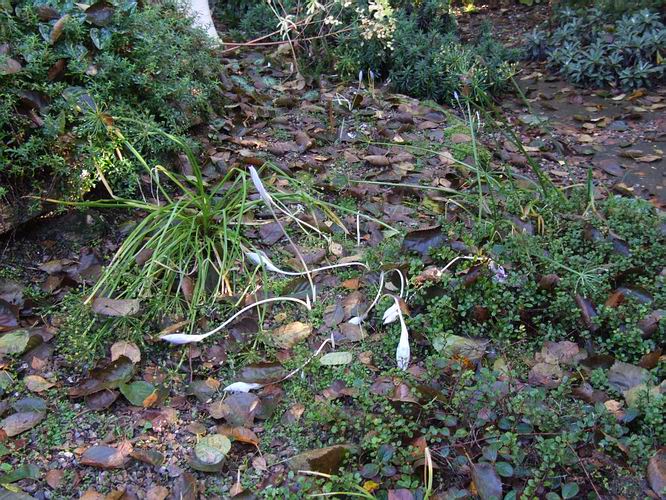
Leaves on beds
Despite the mild weather, parts of the garden are looking quite messy and are needing worked on. Firstly I must remove the leaves from the beds and areas that are mulched with gravel but I will wait until they have dried out a bit first and then lift them with my electric leaf-vac. Also due to the warm weather there are more weeds around and they are in flower and will soon scatter their seeds if we do not get them first, this is the big priority. There never seems to be enough time to keep on top of all the jobs that have to be done and as I prepare to head off to speak to groups in Norwich and Cambridge next week I am conscious that the weeding at least must get done before then.
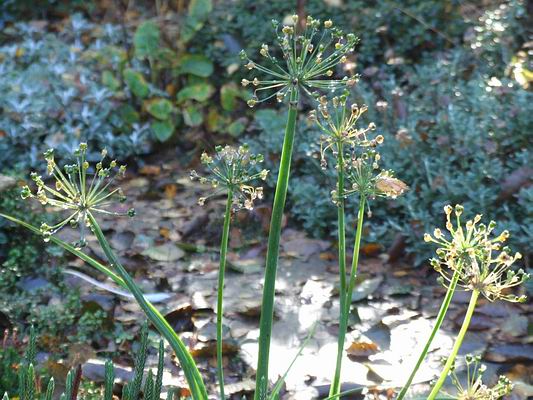
Allium seed heads
There is not much of bulb interest that I have not shown you already outside in the garden today but I did think that this allium seed head was nice and decorative with a bit of back light.
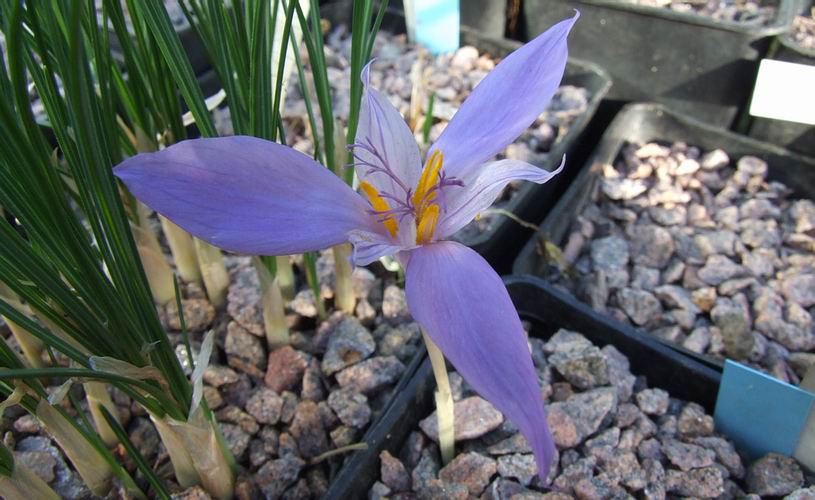
Crocus banaticus
It is a different story under glass where there is a lot of growth and much to see. This is a very nice compact form of Crocus banaticus that I raised from seed collected in Romania; it always flowers at around half the height of any of the other forms that we have.
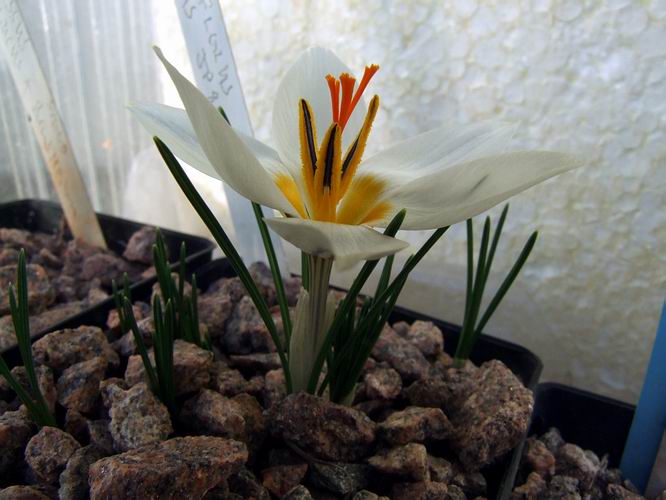
Crocus biflorus melantherus
While Crocus banaticus is without question an autumn flowering species, Crocus biflorus melantherus is really a spring flowering crocus that does not know the time. For some reason it regularly flowers some months before the rest of its relatives and it gives us a reminder of what we can look forward to in spring when the Crocus biflorus group get into their full flowering mode.
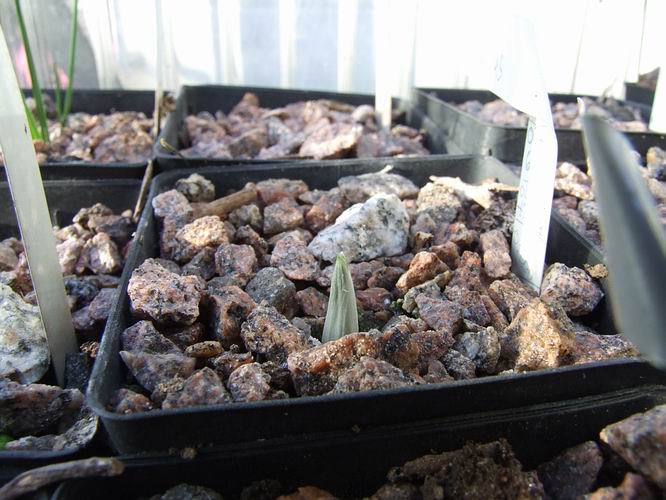
Crocus alatavicus
While checking up on the pots I found a fat bud of Crocus alatavicus poking through the gravel. This species usually flowers in February and I hope that it is not going to be fooled into flowering early by our mild autumn conditions.
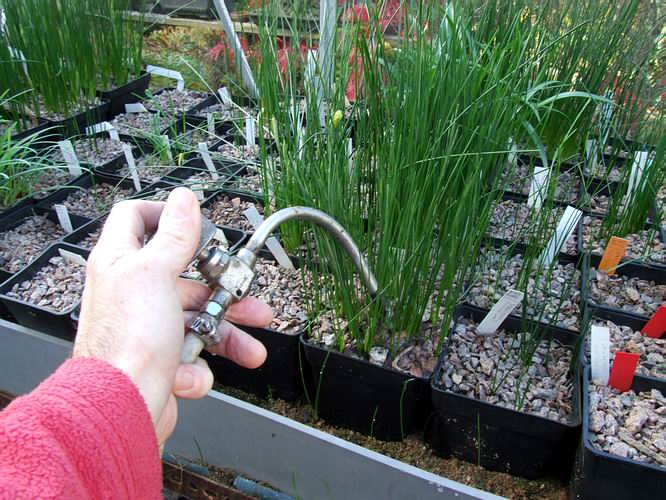
Watering pots with leaves
Many of the Narcissus leaves and buds are very well developed and need watering as they have used up most of the moisture in their pots. I always try and water in the morning on a bright sunny day so that any surplus moisture has a chance to evaporate and not cause any dampness problems. I flood all the pots that have a good growth of leaves: remember my rule of thumb is to water in proportion to the amount of leaves showing.
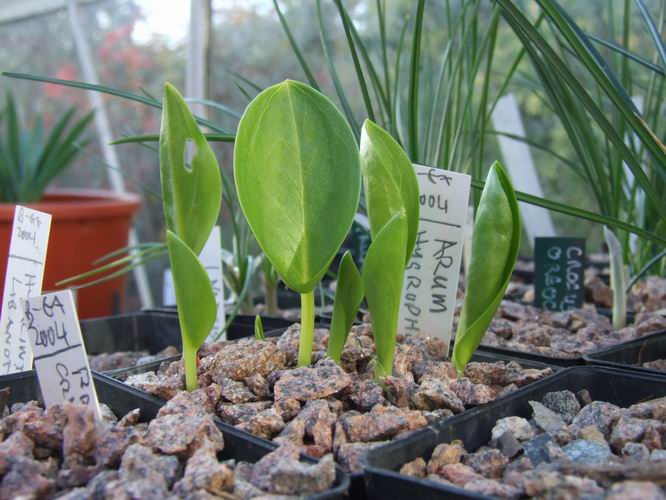
Arum leaves
Other bulbs with leaves showing will also require some water like this pot of Arum bulbils that I got as small offsets from the Bulb Exchange a few years ago and they are still in a ridiculously small pot. I will have to give them a bigger pot next year as most arums need a good root run to grow and flower well, I should never have taken them but I just cannot help myself.
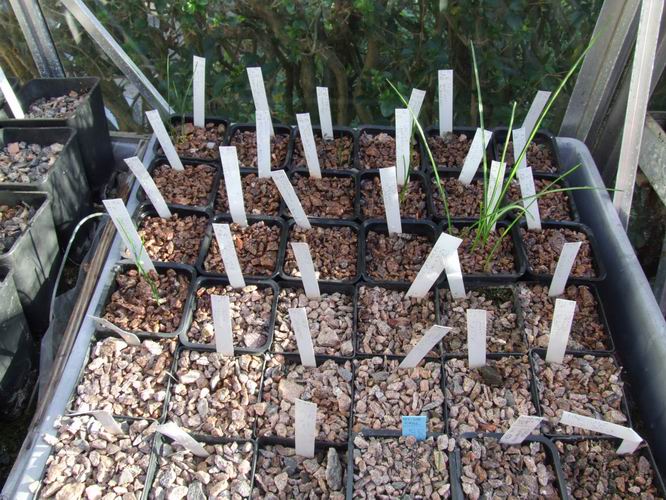
Watering seedling pots
Back to watering; as a general rule for this time of year I only water into pots that have leaves showing but there are always exceptions to every rule. When it involves seed pots or pots with very young seedling bulbs in, then I will give them a quick water, not a flood but just enough to ensure that the young roots of the bulbs or germinating seed have enough moisture to grow and that they do not dry out completely which could kill not only the roots but the juvenile bulb as well.
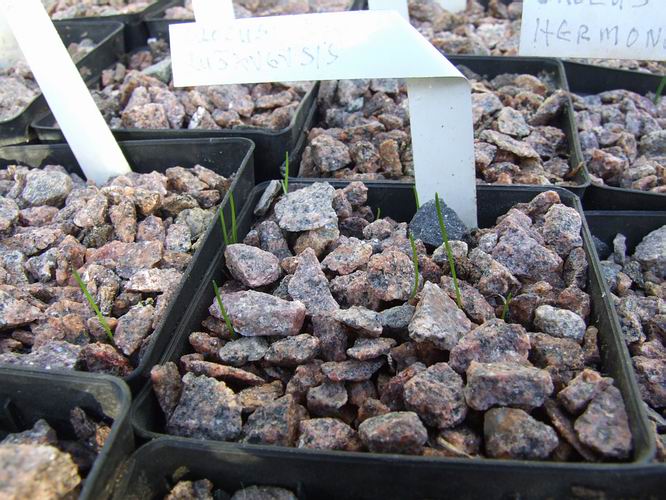
Crocus rujanensis seedlings
A good example of this is this pot of Crocus rujanensis which I do not expect to see above ground until January or February but notice that the seed that I sowed back into the pot with the parent bulb is germinating now so I have given this pot a gentle watering.
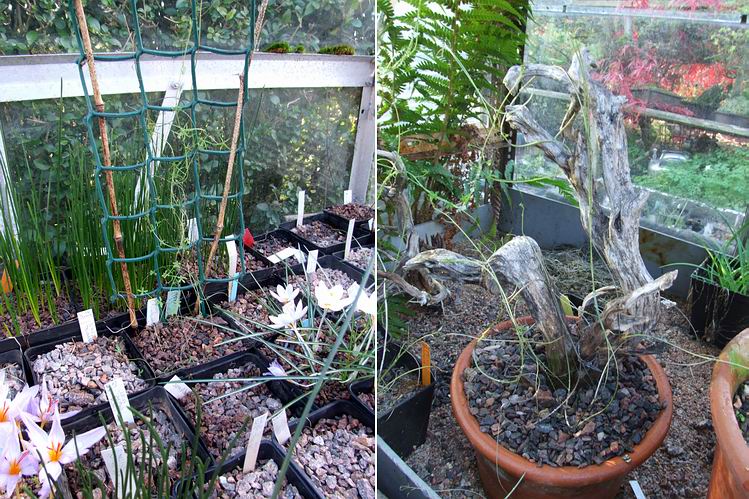
Tropaeolum azureum
One plant that will not forgive you if you let it get dry after the September storm is Tropaeolum azureum. If you let it get dry at all after it has sent out its first root then it will immediately return to its dormant state for at least the rest of that year. On the left you can make out a pot of two year old seedlings that are well into growth and climbing up the plastic mesh support I have given them. I hate seeing this beautiful plant climbing up something as artificial as plastic mesh but for this pot of seedlings I have to accept this as the most practical method to prevent the plants from climbing up and over every other bulb in the vicinity. However with our mature tuber, which is one of the very few bulbs that I still have in a clay pot, I have provided it with a nice piece of weatherworn juniper root, picked up on a mountain walk many years ago, to climb over and look a bit more natural.
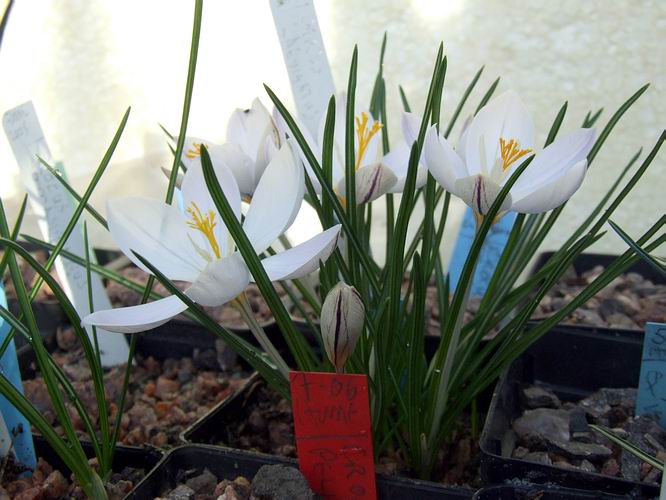
Crocus laevigatus
Since the two autumn storms I have also been watering all the crocus pots in proportion to the amount of leaves showing. Some Crocus species flower some time before their leaves come into growth and as the leaf growth usually mirrors the root growth it is best to wait for the leaves before you water into the pot. Crocus laevigatus is one of the species whose leaves come at the same time as the flowers and so requires watering now.
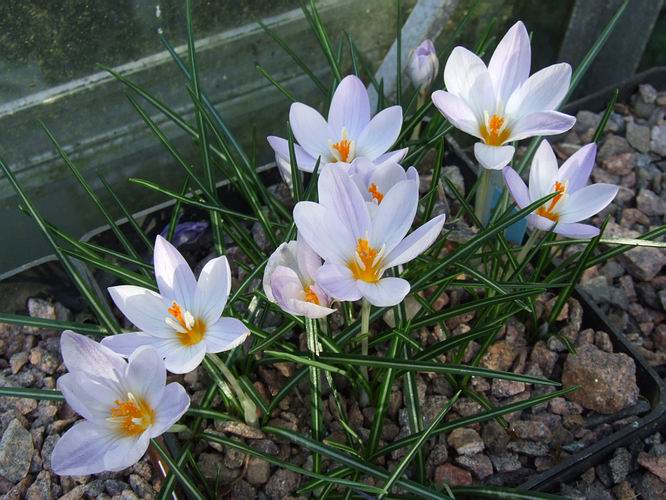
Crocus laevigatus flowers
If I had to pick only one autumn crocus species to grow I think it would be Crocus laevigatus because it is short and compact, shows considerable variation in the markings on its flowers and also by growing a number of clones you can have flowers from October until February as it bridges the gap between the autumn and spring flowering crocus.
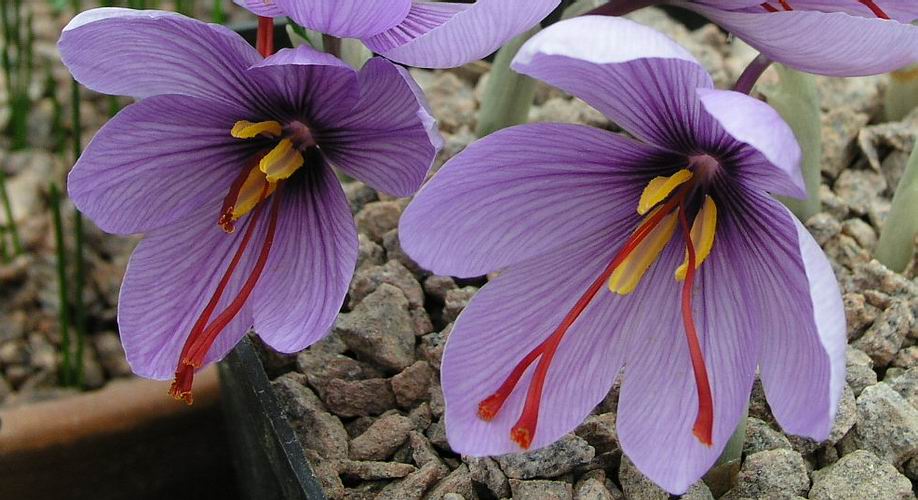
Crocus sativus
I had to go back to my 2004 picture archive for this picture of Crocus sativus because I have not flowered it this year. As a result of my appeal for information to help me I was delighted to get a letter from David B Stephens, of Crocus Group fame, who says 'I had never been successful in growing it down here in the banana belt, (Surrey) until I got advice from a commercial grower in Wales.'
David then goes on to say: - 'Growing in pots doesn't work. Open ground, sunny well drained and a raised bed if possible. The secret is to grow them like potatoes. Very fertile organic soil with masses of bonfire ash ridged up over corms at least 8" deep. I have done this now for the last five or so years and the results are astonishing. I dig them to go in the airing cupboard for the summer months and every year the main corm is ping pong ball size and produces 3-5 cormlets at least ¾" in diameter. The reason they go into the airing cupboard is because the Spanish Saffron Industry research board has indemnified that an optimum storage temperature of 30deg.C for 6 weeks results in multiple flowers. I usually manage 2-3 flowers per corm but the Spanish farmers get 8-9, it's a climate thing.'
Thanks for sharing this information with me, David and allowing me to reproduce it in the bulb log - now we all know how to do it so let's try.
Crocus sativus has been cultivated for saffron for thousands of years and there are no records that state it was ever anything but a sterile clone suggesting that the selection we know was made hundreds if not thousands of years ago. It is a plant that obviously has very particular needs to be grown successfully and this is exactly why I like to grow bulbs from seed. Then we get a selection of forms each able to adapt to slightly different growing conditions instead of one very fussy form. It is unfortunate that in the case of C. sativus we will not get the chance unless by a quirk of nature and a genetic mutation some one might, and it is a big might, get a seed or two and if you think that saffron is expensive how much would a seed be worth?
^ back to the top ^
|

